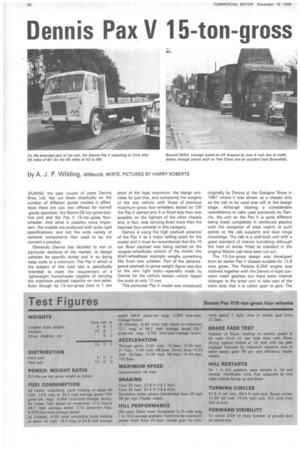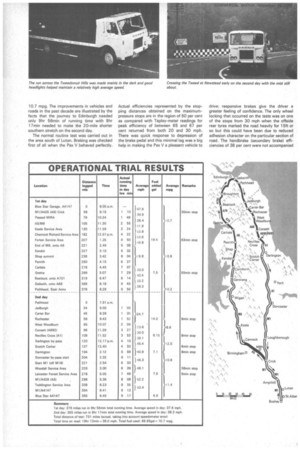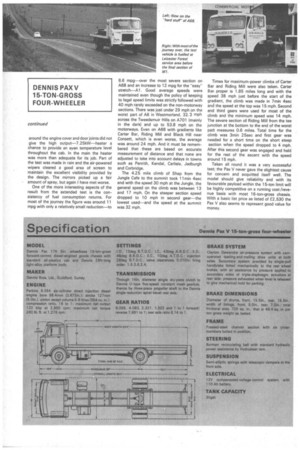Dennis Pax V 15-ton-gross four-wheeler
Page 38

Page 39

Page 40

Page 41

Page 42

If you've noticed an error in this article please click here to report it so we can fix it.
by A. J. P. Wilding, MIMechE, MIRTE, PICTURES BY HARRY ROBERTS
DURING the past couple of years Dennis Bros. Ltd. has cut down drastically on the number of different goods models it offers. Now there are just two offered for normal goods operation, the Maxim 28-ton-grosstractive unit and the Fax V 15-ton-gross fourwheeler. And what is possibly more important, the models are produced with quite rigid specifications, and not the wide variety of optional components that used to be the concern's practice.
Obviously Dennis has decided to aim at particular sections of the market, to design vehicles for specific duties and in so doing keep costs to a minimum. The Fax V which is the subject of this road test is specifically intended to meet the requirement of a lightweight four-wheeler capable of carrying the maximum payload capacity on two axles. Even though its 15-ton-gross limit is 1 ton short of the legal maximum, the design provides for just that, and comparing the weights of the test vehicle with those of previous maximum-gross four-wheelers tested by CM the Pax V carried only 5 or 6cwt less than was possible on the lightest of the other chassis and, in fact, was carrying 6cwt more than the heaviest four-wheeler in this category.
Dennis is using the high payload potential of the Fax V as a major selling point for the model and it must be remembered that the 10 ton 8owt payload was being carried on the longest-wheelbase version of the model; the short-wheelbase example weighs something like 5cwt less unladen. Part of the advantageous payload-to-gross weight figure was due to the very light body—specially made by Dennis for the vehicle tested—which tipped the scale at only 12 cwt.
This particular Fax V model was introduced
originally by Dennis at the Gaslgow Show in 1967 where it was shown as a chassis only as the cab to be used was still at the design stage. Although bearing a considerable resemblance to cabs used previously by Dennis, the unit on the Pax V is quite different being made completely in reinforced plastics with the exception of steel inserts at such points as the cab supports and door hinge mountings. The cab is a well-built unit with a good standard of interior furnishing although the host of extras fitted as standard in the original Maxim cab have been cut out.
The 15-ton-gross design was developed from an earlier Fax V chassis suitable for 12.9 tons gross. The Perkins 6.354 engine was retained together with the Dennis U-type constant mesh gearbox but there were internal changes to the latter unit to take care of the extra duty that it is called upon to give, The suspension follows the same pattern as the lighter Fax V but strengthened to meet the higher axle loads and both the front and rear axles receive the same treatment to allow plating for 5 and 10 tons respectively. The rear axle has a stiffer casing with new internal parts and there has been the redesigning necessary to allow 10.00-20 tyres to be accommodated. The chassis frame has been strengthened by the use of full-length stitch-welded flitch plates on the upper and lower flanges. And two cross-members in the area of the rear axle are stronger than those used on the lighter chassis.
The steering box in the 15-ton Fax is heavier than on the 12.9-ton and has power assistance as standard whereas this was not even an option on the earlier chassis. The brake system is completely new. Instead of a vacuum-hydraulic system the 15-ton Pax has a full air layout with 'triple-diaphragm chambers at the driving axle to allow for air assistance to handbrake application in providing the required 25 per cent secondary brake.
Performed well
As well as a full normal road test programme, the Pax V was taken on the 731-mile extended test route devised by CM to prove a vehicle over all the conditions that it is likely to meet in service. On all the tests, the Pax V came out well. The results of the normal road test were similar to those on previous tests of 16-ton-gross four-wheelers. With less power than is usual, acceleration times were slightly extended but braking results were better than most and the fuel consumption was about 0.5 mpg better than the average for up to 40 mph running and between 1 and 2 mpg better on a high speed test.
The Fax V gave a very good account of itself on the extended test. As this is the first four-wheeler that has been driven over the run to Edinburgh and back, comparisons cannot be made, but the 731 miles was covered in a total time of less than 19 25hr for an average 10.7 mpg. The improvements in vehicles and roads in the past decade are illustrated by the facts that the journey to Edinburgh needed only 9hr 56min of running time with 911r 17min needed to make the 20-mile shorter southern stretch on the second day.
The normal routine test was carried out in the area south of Luton. Braking was checked first of all when the Fax V behaved perfectly.• Actual efficiencies represented by the stopping distances obtained on the maximumpressure stops are in the region of 50 per cent as compared with Tapley-meter readings for peak efficiency of between 65 and 67 per cent returned from both 20 and 30 mph. There was quick response to depression of the brake pedal and this minimal lag was a big help in making the Fax V a pleasant vehicle to drive; responsive brakes give the driver a greater feeling of confidence. The only wheel locking that occurred on the tests was on one of the stops from 30 mph when the offside rear tyres marked the road heavily for 15ft or so but this could have been due to reduced adhesion character on the particular section of road. The handbrake (secondary brake) efficiencies of 38 per cent were not accompanied by any wheel locking.
The Dennis U-type gearbox is not one of the easiest on the market with which to make clean changes when first taking over the driving seat. But the box did not complain too greatly at the -snatch" technique used for the through-the-gears acceleration runs and the times obtained were reasonable. The directdrive accelerations produced times which are slightly longer than the normal for this type of vehicle but nevertheless the engine pulled away quite happily from the low speed of 10 mph.
Fuel consumption
Fuel consumption results have already been referred to. These were carried out on the A6 south of Luton—a six-mile out-and-return run for trunk-road figures—and on M1 from A6 junction to A5120 intersection and back--a total distance of 18.2 miles—for the highspeed run. This stretch of M1 north of A6 spur was used because the usual circuit to A4147 and back was unsuitable due to road works. The same applied to the southern leg from A5120 during the unladen checks so this particular run was ended just before the roadworks started, three miles short of A6. An extremely good figure of 13.3 mpg was returned for the up-to-40 mph test unladen but as usual, the high-speed result when unladen was not a great deal different from the consumption on the laden test-12.1 mpg as against 11.5 mpg.
The Pax V also performed well on the hill tests. A rather wide gap between first and second gears meant that the former had to be used for a good part of the climb. First was engaged for almost half of the 5min 25.4sec needed for the total climb of Bison and the engine was on the governor for most of this; the minimum speed of 7 mph compares with the maximum or 8 mph recorded in first gear. The fade tests also gave a satisfactory result with a drop of only 11 per cent in efficiency after the descent.
Maximum speeds in the gears were checked when running between tests. They were 8, 16, 27 and 39 mph with the maximum speed 59mph. These figures were as recorded by the speedometer, this instrument being accurate at all speeds.
Driving the vehicle during the normal road test gave rise to only one or two criticisms of the design. I felt that the mirrors could be improved as the fixing was not sufficiently rigid to eliminate vibration and the flat glasses did not allow an adequate view of the rear, particularly on the nearside where the original unit proved to be almost useless. It was agreed that some modification would be made for the long run. Additional steady brackets eliminated the vibration completely and an extra convex mirror on the nearside gave the view that I wanted in that area. There was some "sticking" in the steering mechanism on full left lock which was cured by readjustment of the stops but apart from this the only change I felt needed was the fitting of a grab handle on the driver's side to improve access to the cab. There was argument between Ken Martlew, technical director of Dennis and myself on this, as he held the view that the steering wheel served the purpose but I am still convinced that the most suitable thing to hold when getting into a cab is something that is fixed.
These were very minor criticisms really and as nothing compared to the good points of the design. The chassis was very pleasant to drive with adequate power and excellent steering and suspension. These points were strongly confirmed during the extended test and the journey from Hemel Hempstead to Edinburgh did not end with undue fatigue either for Terry Flack of Dennis or for me—we shared the driving.
I had expected to be more tired than I was after the test because the level of noise in the cab was on the high side and this can play a big part in producing a feeling of fatigue. It had been intended to try out a quilted cover over the engine cowl but the Dennis turned up without this item. I do not think that it would have made much difference anyway as noise also gets through other parts of a cab struc ture. But I feel that some additional insulation is needed under the Pax V cab to meet the standard of interior quietness now being rea ched in goods chassis.
As before, the long-distance run brought out points about the design that it is not possible to appreciate on a normal test and the 100-odd miles of driving that this involves. The only major point with the Pax V, however, was the level of noise in the cab —and I have met worse in this respect. The overriding impression was of a pleasant vehicle to drive primarily due to the excellent steering, suspension and brakes.
Seating
The seating was pretty good but the driver's squab felt rather hard and uncomfortable after four or five hours at the wheel.. The optional Chapman Superide sprung-base structure would probably have been of benefit. The controls were in general well placed and little effort was called for in driving although the clutch was on the heavy side. But one control that could be improved is the stalk for the flashing indicator switch on the left side of the steering column. A Longer stalk would overcome the need to "reach" under the wheel to operate the switch.
The start of the second leg of the run was made in an ambient temperature close to freezing point and two or three small draughts
around the engine cover and door joints did not give the high output-7.25kW—heater a chance to provide an even temperature level throughout the cab. In the main the heater was more than adequate for its job. Part of the test was made in rain and the air-powered wipers cleared a good area of screen to maintain the excellent visibility provided by the design. The mirrors picked up a fair amount of spray, but again I have met worse.
One of the more interesting aspects of the result from the extended test is the consistency of fuel consumption returns. For most of the journey the figure was around 11 mpg with only a relatively small reduction—to 8.6 mpg—over the most severe section on A68 and an increase to 12 mpg for the "easy" stretch—A1. Good average speeds were maintained even though the policy of keeping to legal speed limits was strictly followed with 40 mph rarely exceeded on the non-motorway sections. There was just under 29 mph on the worst part of A6 in Westmorland, 32.3 mph across the Tweedsmuir Hills on A701 {mainly in the dark) and up to 53.8 mph on the motorways. Even on A68 with gradients like Carter Bar, Riding Mill and Black Hill near Consett, which is even worse, the average was around 24 mph. And it must be remembered that these are based on accurate measurement of distance and that none are adjusted to take into account delays in towns such as Penrith, Kendal, Carlisle, Jedburgh and Corbridge.
The 4.25 mile climb of Shap from the Jungle Cafe to the summit took 11 mm 4sec and with the speed 30 mph at the Jungle, the general speed on the climb was between 13 and 17 mph. On the steeper section speed dropped to 10 mph in second gear—the lowest used—and the speed at the summit was 32 mph. Times for maximum-power climbs of Carter Bar and Riding Mill were also taken. Carter Bar proper is 1.85 miles long and with the speed 38 mph just before the start of the gradient, the climb was made in 7min 4sec and the speed at the top was 15 mph. Second and third gears were used for most of the climb and the minimum speed was 14 mph. The severe section of Riding Mill from the tee junction at the bottom to the end of the worst part measures 0.6 miles. Total time for the climb was 3min 25sec and first gear was needed for a short time on the short steep section when the speed dropped to 4 mph. After this second gear was engaged and held for the rest of the ascent with the speed around 15 mph.
Taken all round it was a very successful test: the Pax V never gave the slightest cause for concern and acquitted itself well. The model should give reliability and with its favourable payload within the 15-ton limit will be highly competitive on a running cost/revenue basis with most 16-ton-gross chassis. With a basic list price as listed of £2,530 the Pax V also seems to represent good value for money.




















































































































